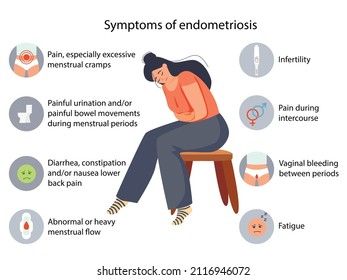Endometriosis is a common gynecological disorder that affects millions of women worldwide. It occurs when tissue similar to the lining of the uterus grows outside of the uterus, causing pain and other symptoms. While endometriosis can be difficult to diagnose, understanding the signs and symptoms can help women seek help sooner and manage their condition effectively.
What is Endometriosis?
Endometriosis is a condition where tissue similar to the lining of the uterus grows outside the uterus. This tissue can be found on the ovaries, fallopian tubes, intestines, and other areas of the pelvis. The tissue responds to hormones in the same way that the lining of the uterus does, thickening and shedding during the menstrual cycle. However, because this tissue has no way to exit the body like the lining of the uterus does, it can cause inflammation, scarring, and pain.
Signs and Symptoms
Endometriosis can present a wide range of symptoms, some of which may be mistaken for other conditions. Common signs and symptoms of endometriosis include:
Chronic pelvic pain
Painful periods
Pain during intercourse
Heavy menstrual bleeding
Infertility
GI symptoms (such as bloating, constipation, or diarrhea)
It’s important to note that the severity of symptoms does not necessarily correlate with the severity of the condition. Some women with severe endometriosis may experience mild symptoms, while others with mild endometriosis may experience severe symptoms.
When to Seek Help
If you are experiencing any of the signs and symptoms listed above, it’s important to seek help from a healthcare provider. Endometriosis can be a challenging condition to diagnose, as the symptoms can overlap with other conditions like pelvic inflammatory disease or irritable bowel syndrome. A healthcare provider will likely perform a physical exam, pelvic ultrasound, or laparoscopy to make an accurate diagnosis.
Early diagnosis and treatment of endometriosis are crucial for managing the condition and preventing complications. Treatment options may include medication, hormonal therapy, or surgery to remove the endometrial tissue. Your healthcare provider will work with you to develop a personalized treatment plan based on your symptoms and the severity of your condition.
Conclusion
Endometriosis is a common condition that can cause significant pain and discomfort for women. By understanding the signs and symptoms of endometriosis and seeking help from a healthcare provider, women can receive an accurate diagnosis and appropriate treatment to manage their condition effectively. If you are experiencing any of the signs and symptoms mentioned above, don’t hesitate to seek help and take control of your health.
Remember, early detection and treatment are key to managing endometriosis and improving your quality of life. Don’t suffer in silence – seek help and take the first step towards better health.
